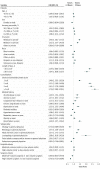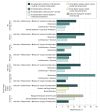Association of Surgical and Hospital Volume and Patient Characteristics With 30-Day Readmission Rates
- PMID: 30869738
- PMCID: PMC6481432
- DOI: 10.1001/jamaoto.2018.4504
Association of Surgical and Hospital Volume and Patient Characteristics With 30-Day Readmission Rates
Abstract
Importance: Thirty-day readmission rates have been suggested as a marker for quality of care. By investigating the factors associated with readmissions in all otolaryngology subspecialties we provide data relevant for the development of risk stratification systems to improve outcomes.
Objective: To establish the association of surgical and hospital volume and patient characteristics with 30-day readmission rates to guide the development of otolaryngology-specific risk stratification models.
Design, setting, and participants: A retrospective cohort study including adult patients who underwent inpatient otolaryngology surgery in New York State between 1995 and 2015 was conducted using the Statewide Planning and Research Cooperative System (SPARCS). Regression techniques were used to describe relationships of patient-level factors, hospital, and surgeon volume to 30-day readmission rates in New York State.
Main outcomes and measures: The main outcome measures were patient-, surgeon-, and hospital-level risk factors for readmission. Secondary outcome measures were rate of readmissions by subspecialty procedure and by diagnosis on readmission.
Results: We identified 254 257 cases of otolaryngology surgery (147 065 women [58%], mean [SD] age 50 [17] years). The 30-day readmission rate was 6%. In a multivariable model, odds ratios (ORs) identified Medicaid insurance (OR, 1.46; 99% CI, 1.36-1.57), Medicare insurance (OR, 1.32; 99% CI, 1.24-1.42), bottom quartile income (OR, 1.08; 99% CI, 1.01-1.15), patient comorbidities measured by the Charlson Comorbidity Index (CCI) (CCI >1; OR, 2.31; 99% CI, 2.16-2.47), length of stay (LOS) (LOS >10 days; OR, 2.29; 99% CI, 2.00-2.45), rhinology (OR, 1.37; 99% CI, 1.24-1.51), laryngology (OR, 1.98; 99% CI, 1.62-2.43), and head and neck cancer (OR, 1.27; 99% CI, 1.17-1.37) procedures as readmission predictors. High-volume surgeons were protective of 30-day readmission (OR, 0.67; 99% CI, 0.635-0.708) relative to low volume. Hospital volume was not significantly associated to readmissions. The most common causes of readmission included wound- (2682 patients, 18%), respiratory- (1776 patients, 12%), cardiovascular- (1210 patients, 8%), and volume- (1089 patients, 7%) related disorders.
Conclusions and relevance: This study evaluated the combined effects of patient-, surgeon-, and hospital-level factors on 30-day readmission after otolaryngology surgery. Socioeconomic factors, patient comorbidities, surgeon volumes, and procedure were significantly associated with 30-day readmission. Though the cause of 30-day readmission is multifactorial, a large portion is driven by socioeconomic factors. Addressing these disparities at the system level is necessary to address the described readmission disparities. The development of risk-stratification models based on patient-, procedure-, and surgeon-level factors may help facilitate resource distribution.
Conflict of interest statement
Figures
Comment in
-
Risk Factors for 30-Day Readmission of Otolaryngology Patients.JAMA Otolaryngol Head Neck Surg. 2019 Apr 1;145(4):337-338. doi: 10.1001/jamaoto.2019.0005. JAMA Otolaryngol Head Neck Surg. 2019. PMID: 30869768 No abstract available.
Similar articles
-
What Is the Association Between Hospital Volume and Complications After Revision Total Joint Arthroplasty: A Large-database Study.Clin Orthop Relat Res. 2019 May;477(5):1221-1231. doi: 10.1097/CORR.0000000000000684. Clin Orthop Relat Res. 2019. PMID: 30998640 Free PMC article.
-
90-day Readmission After Lumbar Spinal Fusion Surgery in New York State Between 2005 and 2014: A 10-year Analysis of a Statewide Cohort.Spine (Phila Pa 1976). 2017 Nov 15;42(22):1706-1716. doi: 10.1097/BRS.0000000000002208. Spine (Phila Pa 1976). 2017. PMID: 28441307
-
Understanding Variation in 30-Day Surgical Readmission in the Era of Accountable Care: Effect of the Patient, Surgeon, and Surgical Subspecialties.JAMA Surg. 2015 Nov;150(11):1042-9. doi: 10.1001/jamasurg.2015.2215. JAMA Surg. 2015. PMID: 26244543
-
Risk Factors for Readmission Within 30 Days After Discharge Following Hip Fracture Surgery: A Systematic Review and Meta-Analysis.J Clin Med. 2025 Apr 17;14(8):2779. doi: 10.3390/jcm14082779. J Clin Med. 2025. PMID: 40283611 Free PMC article. Review.
-
Clinical Biomarkers in Otolaryngology-Head and Neck Surgery.Ear Nose Throat J. 2024 May;103(5):NP301-NP311. doi: 10.1177/01455613211050698. Epub 2021 Oct 25. Ear Nose Throat J. 2024. PMID: 34694171 Review.
Cited by
-
30-day unplanned readmission rate in otolaryngology patients: A population-based study in Thuringia, Germany.PLoS One. 2019 Oct 17;14(10):e0224146. doi: 10.1371/journal.pone.0224146. eCollection 2019. PLoS One. 2019. PMID: 31622434 Free PMC article.
-
Preoperative diabetes complicates postsurgical recovery but does not amplify readmission risk following pancreatic surgery.Gland Surg. 2022 Apr;11(4):663-676. doi: 10.21037/gs-21-648. Gland Surg. 2022. PMID: 35531107 Free PMC article.
-
Trends and Outcomes of Hip Fracture Hospitalization Among Medicare Beneficiaries with Inflammatory Bowel Disease, 2000-2017.Dig Dis Sci. 2021 Jun;66(6):1818-1828. doi: 10.1007/s10620-020-06476-z. Epub 2020 Jul 22. Dig Dis Sci. 2021. PMID: 32700169 Free PMC article.
-
Qualitative Study Assessing Factors for 30-day Readmissions: A Head and Neck Oncology Cohort.Ann Otol Rhinol Laryngol. 2023 Nov;132(11):1293-1299. doi: 10.1177/00034894221147809. Epub 2023 Jan 12. Ann Otol Rhinol Laryngol. 2023. PMID: 36635859 Free PMC article.
-
Household Income as a Predictor for Surgical Outcomes and Opioid Use After Spine Surgery in the United States.Global Spine J. 2023 Oct;13(8):2124-2134. doi: 10.1177/21925682211070823. Epub 2022 Jan 10. Global Spine J. 2023. PMID: 35007170 Free PMC article.
References
-
- Services CfMaM Readmissions Reduction Program (HRRP). 2018; https://www.cms.gov/Medicare/Medicare-Fee-for-Service-Payment/AcuteInpat.... Accessed March 1, 2018.
MeSH terms
LinkOut - more resources
Full Text Sources
Medical




